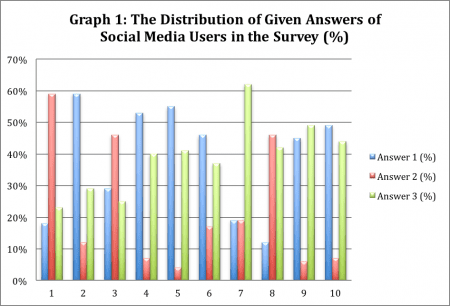Simulated Identities: Social Media and the Reconciliation of the Real and Ideal

Gizem Kiziltunali, Ph.D.
Independent Researcher
 Abstract:
Abstract:
In many online profiles, identities of individuals are not what they actually are, but they are a simulation of what beings, in fact, wish they were. This theoretical analysis proposes that social media generates ideal identities that feed from what actual identities lack in real life. In this regard, the paper asserts that identity construction in social media deconstructs the grand narrative of a single identity an individual has in the actual/physical world. Creating multi-dimensions of a single identity, social media endows beings with endless representation possibilities as to whom they aspire to become. In this regard, identity is reconstructed over and over again in a continuous process controlled by individuals. Through a survey conducted on social media users, the theoretical analysis argues that identity is no longer a concept that gradually evolves. Rather, it is a ‘conscious’ process that we are able to construct through social media. Building on Jacques Derrida’s critical analysis of deconstruction, the paper argues that social media reconciles the binaries of the real/physical and the ideal/virtual and creates hybrid identities that emerge as simulations of beings’ aspirations. First, it will explain and exemplify self-generated identities in social media. Second, it will give an account of Derridean deconstruction and relate Derridean concepts of deconstruction and reconstruction to identity in social media. Finally, the analysis will base its arguments on a survey done by 100 random users of social media.
 Gizem Kiziltunali has completed her PhD in Media at Manchester Metropolitan University and has recently been working as an independent researcher in her field. Having majored in American Studies in her BA and MA, Gizem completed her Mphil in Media at Manchester Metropolitan University where she taught in the department of Media for three years. She attended many academic and inter-disciplinary conferences that took place in prominent universities such as Oxford University and Harvard University. Gizem also attained professional teaching certificates from Oxford University and Trinity College, London. Her research interests include media forms and arts, media psychology, visual culture, semiotics, philosophy and cultural studies. Gizem can be reached at Gizem.kiziltunali@gmail.com
Gizem Kiziltunali has completed her PhD in Media at Manchester Metropolitan University and has recently been working as an independent researcher in her field. Having majored in American Studies in her BA and MA, Gizem completed her Mphil in Media at Manchester Metropolitan University where she taught in the department of Media for three years. She attended many academic and inter-disciplinary conferences that took place in prominent universities such as Oxford University and Harvard University. Gizem also attained professional teaching certificates from Oxford University and Trinity College, London. Her research interests include media forms and arts, media psychology, visual culture, semiotics, philosophy and cultural studies. Gizem can be reached at Gizem.kiziltunali@gmail.com
Introduction
For communication, representation of identity is necessary. In this vein, social media has a lot to do with our identity (Marcus, Machilek, & Schütz, 2006). In today’s world, the concept of identity has grown highly controversial depending on which context it is represented; is it real or ideal? Social media has made it possible to easily construct idealized identities and qualities its users lack and aspire to have. ‘Too many people believe that social media is about technology, it is not; it is about people’ argues Hallam (2013, p. 143). People and communication being central to its process, social media grants individuals an alternative dimension of identity and this dimension renders the concept of identity blurry; questions can be raised as to how same or different our identities in social media are than what they actually are in the physical world. Building on a survey conducted by 100 random social media users, this paper argues that, through social media, many oppositional binaries relating to what an individual actually is and aspires to be are reconciled. The theoretical analysis will seek to explore how social media generates deconstruction and reconstruction in one’s identity through bringing together binaries of the actual/physical and the virtual/ideal. I introduce the philosopher Jacques Derrida’s strategy of deconstruction as a conceptual underpinning to form my ideas related to identity and social media.
A considerable number of scholars have pointed out media as a significant factor that influences human psychology and behaviour (Evans, 2015; Brewer, 2011; Fourie, 2007; Henslin, 2004; Giles, 2003). Having firstly been recognized by the American Psychological Association (APA) in the 1980s, ‘‘media psychology’’ can be explained as, ‘being interested in the roles psychologists play in assessing the impact that various aspects of the media, such as radio or television have on behaviour’ (Brewer, 2011, p. 2). For instance, Hugo Münsterberg analysed the reactions of films in 1970 in his work entitled The Film: A Psychological Study. On the other hand, scholars have studied how new media technologies affect our lives, particularly social media and its networking potential (Pempek, Yermolayeva, & Calert, 2009). As the above studies suggest, media is endowed with a significant potential of influencing our lives, behaviour and psychology. However, in this analysis, I aim to focus on how our offline/actual identity is influenced and deconstructed by us through the way we utilise social media. The paper will point out how this deconstruction leads to the creation of an alternative, ideal identity; a reconstructed one.
A Self-generated Identity
One of the basic qualities of social media is that it is self-generated. This means that it works on a personal basis. Self –generated media ‘describes a variety of new sources of online information that are created, initiated, circulated and used by consumers intent on educating each other about products, brands, services, personalities, and issues’ (Blackshaw & Nazzaro, 2004, p. 2). Blackshaw and Nazzaro’s definition touches upon a variety of subjects. However, in this paper, I will concentrate on the ‘personality’ element. On a personal basis of representation, most self-generated profiles of people are created in relation to what beings wish to tell and show about themselves (Davis, 2012; Jäkälä &Berki, 2004; Amaral & Monteiro, 2002), which leads to many lies individuals tell about themselves. For example, Hancock, Toma & Ellison (2007) write that many users lie while using online dating services. To exemplify, the concept of ‘‘Catfishing’’ (Slade, Narro & Buchanan, 2014, p. 241) describes users’ act of creating profiles with idealized information so as to form relationships with other users.
Representation of oneself, observation of how others represent themselves, and the pathways we choose to represent ourselves are significant topics that are discussed in relation to social media. According to Goffman (1959), individuals in their social life can be defined as both the actor and the audience. In this respect, they perform in a certain way while living in a society. In return, as the audience, they observe how others perform as well. Goffman’s theories are in agreement with the dynamics of social media; many users present their identity traits through the way they engage with online communities, posts they like and the way they display their interests in social media platforms. These elements create an identity performance that can semiotically be read by other users. In return, other users do the same and the online platform becomes a stage of performers where people exhibit their identities and observe others exhibit their own identities. Jäkälä and Berki (2012) write that, ‘the reflection of one’s identity needs the others, and cyberspace communities help their members to identify and being identified both on the level of personal and collective identities’ (6). The scholars add that,
Management of self-presentation and identities also takes place when people enter online communities. By picking up the username, nickname or alias and selecting or creating personal information that they want to share with others, they simultaneously decide how they wish to be percieved by other members of the community. This also emphasizes the relationship between community, technology and identity (6).
Davis (2012), on the other hand, suggest that social media and the communication possibilities it provides, allow individuals the opportunity to alter themselves in a way that is hard to do in social life (639). As the abovementioned scholars suggest, self-generated profiles that are created by their users enable representation in a way that users actually wish themselves to be presented to others. In other words, through social media, what users aspire in relation to their identity is provided on the digital realm.
Having explained and exemplified what virtual identities are in the realm of social media, what follows will give an account of what deconstruction and reconstruction are, how they take place and what they lead to, in relation to Derridean philosophy and identity construction in social media.
Jacques Derrida, Deconstruction of the Actual/Physical Identity, and the Reconstruction of the Virtual/Ideal Identity
Written in 1967, Of Grammatology is Jacques Derrida’s book that developed the method of deconstruction. Through the critical analysis of deconstruction, and with regards to the texts of Rousseau, Saussure, Hegel and Husserl, the philosopher shows ungrounded aspects that have been accepted as the main elements related to the grand narratives in Western thought since Plato. By analysing different aspects of texts, Derrida points out that the grand narratives related to them are all falsified and that there is no fixed but an infinite flux of meaning that takes place within texts.
The orthodox approach of Western philosophy that Derrida challenges is called as ‘‘metaphysics of presence’’ (Derrida, 1967). According to metaphysics of presence, Western tradition grants individuals with undisputable facts (Sarup, 1993; Best & Kellner, 1991). To Derrida, binary oppositions and their hierarchical position (good/evil, rich/poor, ugly/beautiful, holy/cursed) lead to a fixed centre of truth. With deconstruction, Derrida uproots Western thought that uses the hierarchical order of concepts to create fixed and unquestionable truths. He does so by showing that binaries depend on each other.
The philosopher further asserts that deconstruction is an ‘incessant movement of recontextualization’ (1988, p. 136). Derrida’s deconstructive reading of texts uproots grand narratives to reconstruct alternative, new meanings and perceptions that go beyond traditional thinking. As a result, deconstruction creates new visions with regards to truth through challenging oppositional concepts and fixed assumptions. On this account, deconstruction could be understood as a reconstruction. Paul Patton (2004) notes that in,
‘Psyche: Invention of the Other’, first presented as a series of lectures in 1984, Derrida announces that ‘deconstruction is inventive or it is nothing at all’. He immediately adds that, in order for this to be true, deconstruction must call into question the traditional concept and status of invention. Traditionally, ‘invention’ refers to the coming of something new, something that is therefore other to what has gone before and that ‘at the moment when it comes about’ conforms to no pre-existing status or rule (in Reynolds & Roffe, p. 29).
The deconstruction of the actual identity an individual has in the physical world can be approached by Derridean deconstruction. Akin to how Derrida goes against a single meaning within texts, creating a ‘‘technological identity’’ (Amaral & Monteiro 2002) in line with what one aspires to be, leads to the deconstruction of a single identity of a person that exists in the physical world. This is because building on what one lacks and aspires to become, the digital realm creates a new identity and marks the deconstruction of an existing one. Thus, multiple dimensions of one’s actual, existing identity are created. Similar to Derrida’s assertion that binaries depend on each other, deconstruction of one’s actual identity happens by reconciling the actual lack in the physical world and the virtual presence of aspired qualities on the digital realm.
I extend Derrida’s ideas further to argue that social media offers an infinite reconstruction of an individual’s identity as it gives the opportunity to endow beings with endless meaning and representation possibilities related to their identity. Like Derridean deconstruction that generates many different meanings instead of a single, fixed one within texts, social media saves individuals from the grand narrative of a single identity. This is because social media provides endless alternatives as to whom its users could become. Thus, identity can be described as ‘a realm of discourse rather than as a real thing or permanent structure of the mind’ (Turkle, 1995, p. 178), in social media. In this regard, through social media, people’s identities change and fluctuate as they carry on playing with meanings and representations related to themselves (Hutton, 1988).
What follows will put my arguments regarding social media and identity in practice through a survey conducted on 100 random social media users.
Data
In this theoretical analysis, a hundred people were randomly asked to take the survey. The participants were chosen regardless of their gender, age, education level or ethnicity. Given the fact that all participants have a personality, the only element taken into consideration was their active use of social media. The participants’ nationalities included American, Norwegian, Arabic, Turkish, Indian, British, Russian and Scottish. The survey was completed in a month. Participants were asked to choose amongst three answers which were: yes (answer 1), no (answer 2), and sometimes (answer 3). Table 1 displays the questions and table two displays the numeric and percentage distribution of answers in the survey. Graph 1, on the other hand, shows the distribution of given answers of social media users in the survey.
Table 1: Questions of the Survey
- Have you at least once used representations, information or posts that would lead your followers to misconceptions about your actual identity in social media accounts such as Facebook ?
- Do you ever see others lie about their identities or personality traits in social media accounts?
- Does social media help you to create and recreate your identity?
- Do people use social media to present themselves in line with what they wish they were in terms of their identities?
- Does social media encourage subjects to lie about their real identities by creating idealized identities?
- If one lies about their identity traits in social media, does it provide a sense of relief in the users’ psychology?
- Do the identities in social media accounts highly differ from individuals’ actual identities in real life?
- Do you find social media trustworthy in terms of the notion of identity?
- Do you think social media creates multiple identities of a single persona through creating idealized personality traits users aspire to have?
- Is ‘social media lies about identity’ a psychological problem related to one’s aspirations?
Table 2: Numeric and Percentage Distribution of Answers in the Survey
| Questions | Number (N) | Percentage (%) | ||||
| Answer 1 | Answer 2 | Answer 3 | Answer 1 | Answer 2 | Answer 3 | |
| 1 | 18 | 59 | 23 | 18 % | 59 % | 23 % |
| 2 | 59 | 12 | 29 | 59 % | 12 % | 29 % |
| 3 | 29 | 46 | 25 | 29 % | 46 % | 25 % |
| 4 | 53 | 7 | 40 | 53 % | 7 % | 40 % |
| 5 | 55 | 4 | 41 | 55 % | 4 % | 41 % |
| 6 | 46 | 17 | 37 | 46 % | 17 % | 37 % |
| 7 | 19 | 19 | 62 | 19 % | 19 % | 62 % |
| 8 | 12 | 46 | 42 | 12 % | 46 % | 42 % |
| 9 | 45 | 6 | 49 | 45 % | 6 % | 49 % |
| 10 | 49 | 7 | 44 | 49 % | 7 % | 44 % |
Table 2 represents the distribution of given answers both in numeric and percentage and shows the frequency of them in the survey. According to the results, it is ironic that most of the participants denied to have lied in social media regarding their identities (59%), while the same percentage of answers (59%) was obtained when they were asked if they have seen others lie in social media.
Further, it can be interpreted that most social media users are not sure whether identities in social media accounts highly differ from individuals’ actual identities in their real life (62%). Other participants have completely opposite answers for this question. This represents that many users occasionally observe other users making use of social media to create identity traits that differ from their actual identities. In this respect, the result indicates that differences in identities that are displayed in social media accounts feed from what the individuals’ actual identities in real life lack or miss.
According to question 5, only a few social media users believe that social media does not encourage subjects to lie about their real identities by creating idealized identities (4%). Therefore, it can be said that social media provides a perfect platform for users to lie so as to create idealized identity traits users aspire to have; participants hold a positive belief that social media helps them make up for what their actual identities lack by generating idealized, virtual identities (55%). 53% of the participants, on the other hand, said they use social media to present themselves in line with what they wish they were in terms of their identities. This highlights the fact that social media reconciles binaries of the real and ideal; it offers the platform that helps them compensate what their identities are missing in actual life by providing the idealized identity traits they aspire to have.
Results
The findings of this theoretical analysis suggest that actual identities that exist in the physical world are deconstructed by social media. This deconstruction takes place through the way social media provides the opportunity to create idealized identity traits that individuals do not have but aspire to have in real life. The reconciliation of the real and ideal and the reconstruction of a virtual identity marks the power of social media in ‘conscious’ identity creation. The analysis has also put Goffman’s theory into practice through its questions; it has asked social media users’ observations regarding other users (as audience) and directed similar questions to themselves as performers of their own identity (as actors). It has reached the ironic conclusion that most people observed others lie in social media while claiming they, themselves never did.
Conclusion
Through a survey conducted on social media users, this theoretical analysis has argued that with regards to one’s identity, social media brings together what real life lacks in the present with what the digital realm compensates. On this account, real identity and digital identity emerge as co-dependent; unwanted physical reality is eliminated and aspired identity is fulfilled through virtual possibilities. The findings of the survey have shown that through social media, individuals get a chance to reconstruct their identity. This reconstruction refers to qualities, meanings and representations related to identity that are generated over and over again by individuals on the virtual platform. Thus, virtual possibilities lead to the creation of multi-layered identities of a single person. Social media, akin to Derridean deconstruction, frees other identity possibilities that lurk under the grand narrative of a single persona of an individual. Thus, an infinite possibility of identity generation appears and the deconstruction of a single identity takes place. On this account, pseudo-identities occur where the concept of identity is merely simulated. Reality does not matter anymore as virtual becomes the place of the ideal. In today’s world, identities are one click away. What is remarkable is that, self-generated media allows us to consciously create our identities. Social media allows us to ‘‘think’’ and ‘‘create’’ our identity rather than letting it evolve as a gradual process. By feeding from our actual existence and what it lacks, we become the masters of our own identity. Even though technological identities are merely a simulation, they are a mirroring of what we long to be. Simulated identities should not be disregarded or underestimated because in today’s growing web of social media platform, it is expected that new media will provide new realities that are of virtual grounding. These new realities, akin to what Derridean deconstruction suggests, will shift the hierarchical positions of the binaries of the real over the virtual.
References
Amaral, M., & Monteiro, M. (2002). To be without being seen: Computer-mediated communication and social identity management. Small Group Research, 33 (5) 575-589.
Best, S., & Kellner, D. (1991). Postmodern theory: Critical interrogations. New York, NY: Guilford Press
Blackshaw, P., & Nazzaro, M. (2004). Consumer-Generated Media (CGM) 101: Word-of-mouth in the age of the Web- fortified consumer. Retrieved August 1, 2015, from http:// www.nielsenbuzzmetrics.com/whitepapers.
Brewer, G. (2011). Media Psychology. New York, NY: Palgrave Macmillan.
Davis, K. (2012) “Tensions of Identity in A Networked Era: Young People’s perspectives on the risks and rewards of self-expression.’’ New Media and Society 14 (4): 643-651.
Derrida, J. (1967). Of Grammatology. (G.Chakravorty, Trans.) Maryland, MD: Johns Hopkins University Press
Derrida, J. (1988). Letter to a Japanese Friend. In D. W. Bernasconi (Ed.), Derrida and Difference (pp. 1-5). Evanston: Northwestern University Press
Evans, L. (2015). Locative Social media: Place in the Digital Age. New York, NY: Palgrave, Macmillan.
Fourie, P. J. (Ed.) (2007). Media Studies: Media History, Media and Society. Cape Town: Juta &Co.
Giles, D. (2008). Media Psychology. New Jersey, NJ: Taylor & Francis.
Goffman, E. (1959). The Presentation of Self in Everyday Life. Harmondsworth: Penguin
Hallam, J. (2013). The Social Media Manifesto: A Guide to Using Social Technology to Build a Successful Business. New York, NY: Palgrave Macmillan.
Hancock, J. T., Toma, C., & Ellison, N. (2007). ‘‘The truth about lying in online dating profiles.’’ Proceedings of the ACM Conference on Human Factors in Computing Systems 449-452.
Henslin, J. M. (2004). Essentials of Sociology. Boston, MA: Allyn and Bacon.
Hutton, P. H. (1988). Foucault, Freud and the technologies of the self. In L. H. Martin, H. Gutman, & P. H Hutton (Eds.), Technologies of the self: A Seminar with Michel Foucault (pp. 121-144). Amherst, MA: The University of Massachusetts Press.
Jäkälä, M., & Berki, E. (2004). Exploring the principles of individual and group identity in virtual communities. In P. Commers, P. Isaias, & M. Baptista Nunes (Eds.), Proceedings of First IADIS Conference on Web-based Commuunities. Lisbon, Portugal, 24-26 March, 19-26.
Jäkälä, M., & Berki, E. (2012). Communities, communication and online identities. In S. Warburton (Ed.), Digital Identity and Social Media. (pp. 1-13). Hershey, PA: IGI Global.
Marcus, B., Machilek, F., & Schütz, A. (2006). “Personality in cyberspace: Personal web sites as media for personality expressions and impressions”. Journal of Personality and Social Psychology 90 (6): 1014–1031
Münsterberg, H. (1970). The Film: A Psychological Study. New York, NY: Dover Publications.
Patton, P. (2004). Politics. In J. Reynolds, J. Roffe, & J. Roffe (Eds.), Understanding Derrida (pp. 26-28). Wiltshire: Cromwell Press
Pempek, T. A., Yermolayeva, Y. A., & Calert, S. L. (2009). College students’ social networking networking experiences on Facebook. Journal of Applied developmental psychology, 30 (3), 227-238.
Sarup, M. (1993). Post-structuralism and Postmodernism. Essex: Pearson
Slade, A. f., Narro, A. J., & Buchanan, B. P. (2014). Reality Television: Oddities of Culture. Plymouth: Lexington Books.
Turkle, S. (1995). Life on the Screen: Identity on the Age of the Internet. New York, NY: Simon & Schutster.




